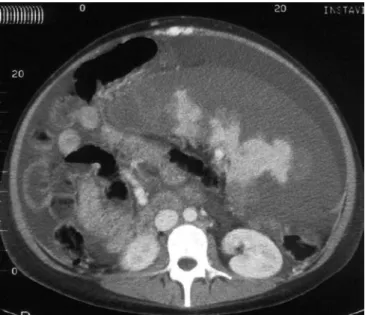Olivier Detry Arnaud De Roover Abdour Kaba Jean Joris Pierre Damas Michel Meurisse Pierre Honore´
Right lobe living-related liver transplantation
in a Jehovah’s Witness
Received: 13 November 2002 Revised: 17 February 2003 Accepted: 7 March 2003
Published online: 16 August 2003
Ó Springer-Verlag 2003
Dear Editors:
Jehovah’s Witnesses (JWs) refuse transfusions of homologous and autologous blood and blood prod-ucts that have been removed from continuity with the body. They ac-cept crystalloid solutions, synthetic colloid solutions, hemoglobin sub-stitutes such as perfluorocarbons or artificial hemoglobin solutions, and recombinant proteins such as eryth-ropoietin or recombinant fac-tor VIIa. Individual decisions need to be made regarding administration of purified fractions of plasma, such as immunoglobulins and albumin, or solid organ transplants. Liver trans-plantation (LT) has been performed in some highly selected and prepared JW recipients [1]. In this report the authors describe the successful transplantation of a young adult using a right liver lobe harvested from her father.
A 17-year-old JW girl (60 kg, 180 cm) was suffering from end-stage liver disease secondary to cirrhotic autoimmune hepatitis. Liver failure was complicated by severe portal hypertension, hyper-splenism, thrombocytopenia (15,000 platelets/mm3), and refractory asci-tes. She refused the use of any blood product other than purified albu-min. In preparation for LT, she underwent iron, folic acid, and erythropoietin therapy, and spleen embolization (Fig. 1), as descri-bed [1], to increase hematocrit and
platelet count, respectively. At first, she was listed for cadaveric whole liver transplantation. Her condition deteriorated to Child–Pugh C liver failure, and living-related LT was considered. Her father (90 kg, 190 cm) proposed himself for dona-tion and was compatible. Right lobe procurement was considered to provide sufficient liver mass to allow immediate liver function, and the procedure of living-related LT was performed on 1 March 2002, using the described technique [2]. For right lobe harvesting, hemostasis of the cut surface of the liver was achieved by contact radiofrequency (Tissue-Link Floating Ball, Tissuelink, Do-ver, N.H.). The right lobe (segments V–VIII) weighed 1244 g, i.e., 2% of the recipient body weight. In the recipient procedure, 20 lg/kg recombinant activated factor VII (Novoseven, Novo Nordisk, Den-mark) was injected at the beginning of dissection and at reperfusion. A temporary surgical end-to-side por-tocaval shunt was created to decompress the splanchnic circula-tory bed during dissection [3]. Continuous-circuit cell salvage, high-dose aprotinin, and argon beam coagulation were also used to limit blood loss during the proce-dure. Right lobe graft function was immediate. No transfusion of allo-geneic red cells, platelets, or fresh frozen plasma was needed either in the donor or the recipient, in
accor-Transpl Int (2003) 16: 895–896
DOI 10.1007/s00147-003-0630-2 L E T T E R T O T H E E D I T O R S
O. Detry Æ A. De Roover Æ M. Meurisse P. Honore´
Department of Liver Surgery and Trans-plantation, University Hospital Sart Til-man B35, University of Lie`ge, 4000, Lie`ge, Belgium
E-mail: oli.detry@chu.ulg.ac.be Tel.: +32-4-3667645
Fax: +32-4-3667069 A. Kaba Æ J. Joris
Department of Anesthesiology, University Hospital Sart Tilman B35, University of Lie`ge, Lie`ge, Belgium
O. Detry
Department of Intensive Care, University Hospital Sart Tilman B35, University of Lie`ge, Lie`ge, Belgium
dance with the patients’ beliefs. Both patients left the ward on postopera-tive day 14, without any complica-tion, and both were in perfect condition with normal liver tests at 1 year of follow-up.Patients under-going LT suffer from severe multiple
coagulation disturbances [4] and of-ten require the use of large amounts of blood products. Preparation of JWs for LT may include erythro-poietin therapy and subtotal arterial spleen embolization to increase hematocrit and platelet count [1].
Aprotinin showed efficacy in reduc-ing bleedreduc-ing durreduc-ing LT [5]. The in-traoperative use of recombinant factor VIIa, which was shown to correct coagulation in cirrhotic pa-tients [6], may in part substitute for fresh frozen plasma or other coagu-lation factors. Bypass avoidance and surgical portal decompression may also reduce intraoperative blood loss. Living-related LT allows the procedure to take place at the best time for both donor and recipient, and this is particularly crucial in JW patients. Particularly, the most experienced surgeons and anesthesi-ologists may then all be present in the operating room.In JWs particu-larly, living-related LT requires the harvesting of sufficient liver mass to avoid small-for-size syndrome and primary graft dysfunction, as no coagulation factors or blood may be used in the early postoperative peri-od. The relatively large liver mass provided in this case may have been a key factor for the success of living-related LT in a JW.
Fig. 1 Abdominal computed tomodensitometry showing 80% spleen embolization of the enlarged spleen and ascites
References
1. Detry O, Honore´ P, Delwaide J, Dondelinger RF, Meurisse M, Jacquet N. Liver transplantation in a Jehovah’s Witness. Lancet 1999; 356:1680. 2. Trotter JF, Wachs M, Everson GT, Kam
I. Adult-to-adult transplantation of the right hepatic lobe from a living donor. N Engl J Med 2002; 346:1074.
3. Belghiti J, Noun R, Sauvanet A. Temporary portocaval anastomosis with preservation of caval flow during orthotopic liver transplantation. Am J Surg 1995, 169:277.
4. Porte RJ, Knot EA, Bontempo FA. Hemostasis in liver transplantation. Gastroenterology 1989; 97:488.
5. Porte RJ, Molenaar I, Begliomini B, et al. Aprotinin and transfusion requirements in orthotopic liver transplantation: a multicentre randomised double-blind trial. Lancet 2000; 355:1303.
6. Bernstein DE, Jeffers L, Erhardtsen E, et al. Recombinant factor VIIa corrects prothrombin time in cirrhotic patients: a preliminary study. Gastroenterology 1997; 113:1930.
